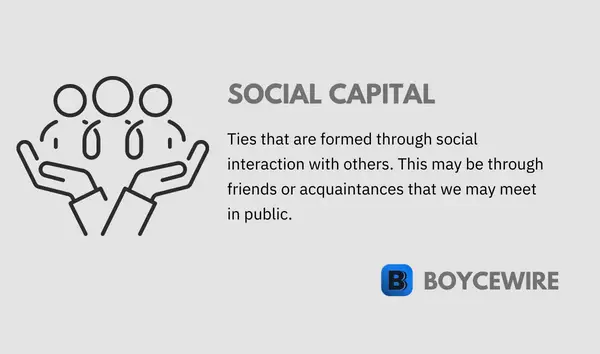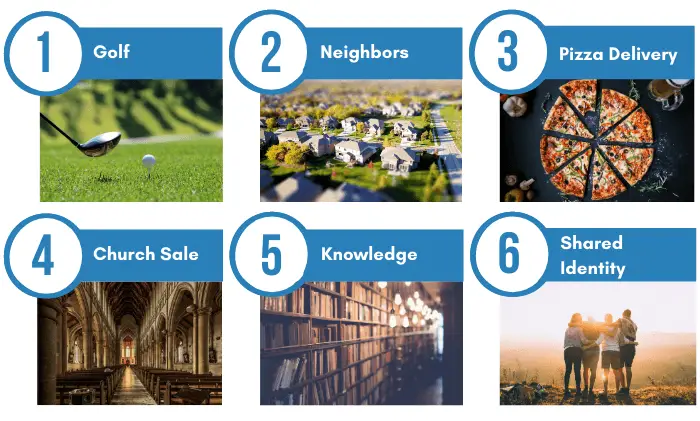Table of Contents ![]()
Social Capital: Definition, Types & Examples

What is Social Capital
Social capital refers to the links and bonds people form through friendships and acquaintances. These links can form through friendship groups, i.e. knowing a friend of a friend. Or, they can occur through daily social interactions. For example, a conversation with the person sitting next to you on the train.
In other words, social capital is the social ties that we develop throughout our lives. Whether it is knowing the right person to contact in finance to get an invoice through or the right teacher who can help with coursework. It is the knowledge and ability to call on the right person to help in a certain situation.
Key Points
- Social capital is the development of relationships that help contribute to a more efficient production of goods and services.
- There are three types of social capital – bonding, bridging, and linking.
- It can make or break businesses. By having a wide range of connections, some are able to thrive as they are able to get work done more effectively and efficiently.
Capital itself is defined as an asset that helps improve the efficiency of production. Social capital, therefore, is defined as the social assets that help improve the efficiency of production.
We can look at it as a social interaction that allows us to build new connections and networks. Or, it can simply be developing interpersonal relationships with others that help with the efficiency of production. This may be through good relationships with suppliers, or even colleagues and employees. This relationship may help motivate workers through friendship ties, or, create more flexible suppliers that are willing to accommodate.
It can help us explain why some firms experience superior managerial performance, efficiency supply chains, mergers, and acquisitions, as well as the improved performance of diverse groups.
The 3 Types of Social Capital
There are three main types of social capital. They are bonding, bridging, and linking. Let us look at them below:
1. Bonding Social Capital
Bonding social capital describes the connections between similar groups of people that share the same characteristics. This might be age, hobbies, relationships, sports teams, or another variable that helps to create a bond between two people or a group of people.
Bonding is the strongest type of social capital as a close relationship between two people is formed. This might come from closely working with a colleague for years and developing a close personal relationship with them. Alternatively, it might come through sitting next to the same person at each local basketball match, thereby developing a close relationship.
Typically, these bonds form through the development of social ties. In other words, friendships. However, they also include family members, as well as neighbors. It is through these connections that people are willing to help each other out and gain ‘social capital’ among their peers. We are more likely to help someone and go out of our way for someone we have a bond with – as opposed to someone we know nothing about.
2. Bridging Social Capital
Bridging social capital differs from bonding in the fact that the ties are not so strong. Instead, the links come from weaker connections such as friends of friends, or colleagues and associates.
The connection is ‘bridged’ in the fact that one person is introduced to another through an intermediary. That intermediary is effective ‘the bridge’ that brings the two parties together.
This form of social capital tends to differ from bonding in the fact that there is greater diversity. Bonding tends to occur between two people or groups of people that have similar interests or characteristics. For instance, you tend to find rich celebrities hanging out with other rich celebrities, who introduce each other to more rich celebrities.
Bridging brings two or more people together who would otherwise not connect – even though they are from similar groups and have the same interests. This may be friends of friends, people who live on the other side of the world, or being introduced to a new colleague – thereby ‘bridging’ the social gap.
One of the important aspects of bridging is that it is horizontal. In other words, social capital is developed between people from the same socioeconomic group – which contrasts to ‘linking social capital’ which develops horizontally between different socioeconomic groups.
3. Linking Social Capital
Linking social capital is an extension of bridging. For example, bridging occurs horizontally, i.e. between people of a similar socioeconomic power or hierarchy. By contrast, linking occurs vertically – i.e. between socioeconomic groups.
Those who are in similar socioeconomic groups are often referred to as a ‘community’. It is outside of those communities that linking takes place. For instance, a footballer may be introduced to an underprivileged boy. The two may develop a relationship and hence be able to leverage a far larger level of resources than previously possible.

If we take an example and consider two socioeconomic classes – the upper class and the working class. There are millions of people in each, yet many of them will stick to their own socioeconomic groups. Through linking, they are able to penetrate the gap between and develop new contacts and ties in between ‘social boundaries’.
Another example could include the CEO of a big company. They probably have no idea what work is like for the day-to-day staff at the bottom. Yet a lower-level manager may introduce them to the staff whereby social capital is formed between the CEO and a general worker. The CEO may benefit from understanding their staff better, so can introduce better working practices to help motivate staff.
At the same time, the lower worker may benefit through advice and connections that the CEO may provide. In turn, we have what is known as a vertical bridge between two groups to generate social capital.
Social Capital Examples

1. Golf
Pierre Bourdieu, a French sociologist, gave an example of golf to demonstrate social capital. Often, business people go out onto the golf course as a way of networking, facilitating business, and cementing social ties.
The issue with golf however is that it is a rather expensive sport, with strict entry requirements in some cases. In turn, it has become known as a luxury sport that only the rich can play-acting as a socialising ground for that socioeconomic group.
2. Neighbours
Having social capital with neighbours can prove fruitful. Perhaps you run out of milk or sugar. So instead of having to go to the shop, your neighbor may be willing to give you some.
Alternatively, they may look after pets or children during vacation periods or emergencies. At the same time, this is economically beneficial. A trip to the store is no longer required thereby saving the cost of time and fuel – nor would the cost of child or pet care be required.
3. Knowledge
Another example of social capital is the transfer of knowledge. For instance, you may have your oven break down whilst cooking a meal for friends. They may have experience with a similar issue before and are able to identify the fix.
In turn, they are able to identify that the filament was blown and a new one is needed. So rather than have an engineer come in and fix a relatively straightforward problem, it costs $10 for a new filament rather than $150.
4. Church Sale
The local church is undertaking a fundraiser to help the homeless in the area. As part of the congregation, they take it upon themselves to invite friends and family and post on social media – providing a free marketing platform. In turn, the church benefits economically from the free marketing.
5. Pizza Boy
Let’s say you order pizza from the same place every time and end up seeing the same delivery boy each time. You get chatting and become on good terms with them.
From the social capital that is formed, the pizza boy may give you some extras or a discount. At the same time, you may be more willing to provide the pizza boy with a tip.
6. Shared Identity
When two individuals share an identity, whether it’s where they come from, religion, or hobbies. These can connect them and create a bond that can act as a form of social capital. For example, we are more likely to help another that we feel are similar to us.
FAQs
Some examples of social capital include:
– Golf: socialising within the business community to develop relationships and create deals.
– Neighbours: may give you milk, bread, or other good so you don’t spend the time and money having to go to the shop.
– Church Sale: churches use their wide community to branch out and link to other parts of society to help fundraise.
– Pizza Boy: If you constantly order from the same pizza place, you may develop a relationship with the delivery driver which could mean free stuff and a large tip for them.
Social capital is the social ties that we develop throughout our lives. Whether it is knowing the right person to contact in finance to get an invoice through or the right teacher who can help with coursework.
The three main types of social capital are: bonding, bridging, and linking.
About Paul
Paul Boyce is an economics editor with over 10 years experience in the industry. Currently working as a consultant within the financial services sector, Paul is the CEO and chief editor of BoyceWire. He has written publications for FEE, the Mises Institute, and many others.

Further Reading
 Dependent and Independent Variables in Economics - An independent variable is one which is changed by the researcher in order to find out what impact it has…
Dependent and Independent Variables in Economics - An independent variable is one which is changed by the researcher in order to find out what impact it has…  Pygmalion Effect: Definition, How it works & Example - The Pygmalion effect is where an individual’s performance is influenced by others’ expectations. In other words, higher expectations lead to…
Pygmalion Effect: Definition, How it works & Example - The Pygmalion effect is where an individual’s performance is influenced by others’ expectations. In other words, higher expectations lead to…  Diseconomies of Scale: Definition, Types & Examples - It is an economic term that defines the trend for average costs to increase alongside output.
Diseconomies of Scale: Definition, Types & Examples - It is an economic term that defines the trend for average costs to increase alongside output. 